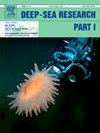Interannual variability in surface mesozooplankton in the Western Antarctic Peninsula during two anomalous years
IF 2.1
3区 地球科学
Q2 OCEANOGRAPHY
Deep-Sea Research Part I-Oceanographic Research Papers
Pub Date : 2025-01-16
DOI:10.1016/j.dsr.2025.104444
引用次数: 0
Abstract
Zooplankton play a key role in the Southern Ocean, are closely linked to oceanographic variations and are highly sensitive to environmental changes. The Western Antarctic Peninsula (WAP) is a critical global climate hotspot where the variability and vulnerability of marine ecosystems are particularly evident. This study aims to characterize the variability of surface mesozooplankton across the Gerlache (GS) and Bransfield (BS) straits. Data were collected with a continuous plankton recorder (CPR) during the austral summer of 2016 (CPR-34 route) and 2017 (CPP-35 route), enabling extensive spatial mapping of zooplankton communities. In 2016, the average sea surface temperature (SST) was 0.57 °C, whereas in 2017, it increased to a maximum of 2.13 °C. The surface salinity (SS) was lower in 2017 (average 33.86). High chlorophyll-a values were recorded in the GS in 2016 (43.78 mg m−3). PERMANOVA revealed significant differences in community composition between the year and location site. Beta diversity analysis revealed nestedness in 2016, with Copepoda dominating the mesozooplankton community, particularly Metridia gerlachei and Metridia longa, which accounted for 85% of the total abundance of Copepoda. In 2017, events of replacement, known as turnover, were observed, with a shift from copepods to salps along with lower local diversity. The BS had a relatively high abundance in both years, reflecting the sampling periods and dial migration patterns. CCA revealed positive correlations between salps and temperature and negative correlations between salinity and copepods. These findings highlight distinct community structure patterns driven by specific environmental conditions linked to major climatic events, i.e., the ENSO and SAM, offering insights into zooplankton responses to anomalous oceanographic conditions in the WAP.
两个异常年南极半岛西部表层中浮游动物的年际变化
浮游动物在南大洋中发挥着关键作用,与海洋变化密切相关,对环境变化高度敏感。南极半岛西部是一个重要的全球气候热点地区,海洋生态系统的变异性和脆弱性尤为明显。本研究旨在研究Gerlache (GS)和Bransfield (BS)海峡表层浮游动物的变化特征。在2016年(CPR-34路线)和2017年(CPP-35路线)的南部夏季,使用连续浮游生物记录仪(CPR)收集数据,实现了浮游动物群落的广泛空间制图。2016年平均海表温度(SST)为0.57°C, 2017年最高为2.13°C。2017年海面盐度(SS)较低,平均为33.86。2016年GS区录得较高的叶绿素a值(43.78 mg m−3)。在年份和地点之间,群落组成存在显著差异。Beta多样性分析显示,2016年中浮游动物群落呈巢状分布,桡足类在中浮游动物群落中占主导地位,其中以Metridia gerlachei和Metridia longa居多,占总丰度的85%。2017年,观察到更替事件,即所谓的更替,从桡足类转向海鞘,同时当地多样性降低。这两个年份的BS丰度都相对较高,反映了采样周期和刻度迁移模式。CCA结果显示,盐度与桡足类呈负相关,盐度与温度呈正相关。这些发现突出了与主要气候事件(即ENSO和SAM)相关的特定环境条件驱动的独特群落结构模式,为了解WAP中浮游动物对异常海洋条件的响应提供了见解。
本文章由计算机程序翻译,如有差异,请以英文原文为准。
求助全文
约1分钟内获得全文
求助全文
来源期刊
CiteScore
4.60
自引率
4.20%
发文量
144
审稿时长
18.3 weeks
期刊介绍:
Deep-Sea Research Part I: Oceanographic Research Papers is devoted to the publication of the results of original scientific research, including theoretical work of evident oceanographic applicability; and the solution of instrumental or methodological problems with evidence of successful use. The journal is distinguished by its interdisciplinary nature and its breadth, covering the geological, physical, chemical and biological aspects of the ocean and its boundaries with the sea floor and the atmosphere. In addition to regular "Research Papers" and "Instruments and Methods" papers, briefer communications may be published as "Notes". Supplemental matter, such as extensive data tables or graphs and multimedia content, may be published as electronic appendices.

 求助内容:
求助内容: 应助结果提醒方式:
应助结果提醒方式:


